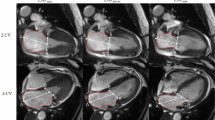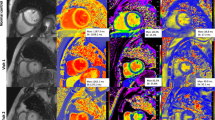Abstract
Objectives
To investigate whether cardiovascular magnetic resonance (CMR) T1 mapping and strain parameters can detect early histological and functional myocardial changes in idiopathic inflammatory myopathy (IIM) with negative late gadolinium enhancement (LGE) and preserved ejection fraction.
Methods
Thirty consecutive patients with IIM (41.5 ± 15.4 years, 24 females) who did not have LGE or reduced left ventricular ejection fraction (LVEF) and 30 age- and gender-matched healthy controls (40.6 ± 14.2 years, 20 females) were recruited. Patients with IIM were further classified into two subgroups according to high-sensitivity cardiac troponin I (hs-cTnI) values: elevated hs-cTnI subgroup (n = 10) and normal hs-cTnI subgroup (n = 20). Myocardial native T1 values, extracellular volume (ECV) fractions, and strain parameters were analyzed in patients with IIM and healthy controls.
Results
Compared with healthy controls, patients with IIM had significantly prolonged native T1 values and increased ECV in each LV segment (p < 0.05). In further subgroup analysis, LV mid-slice native T1 values had the most power to discriminate between patients with elevated hs-cTnI and healthy controls (area under the curve = 0.92). There was no significant difference of global LV strain or strain rates between IIM patients and controls.
Conclusions
Diffuse interstitial fibrosis can be detected by CMR T1 mapping in patients with IIM who do not have LGE or reduced LVEF or elevated hs-cTnI, and it may be a promising method for screening subclinical cardiac involvement in IIM.
Key Points
• Myocardial abnormality in IIM is often subclinical and leads to poor prognosis.
• Conventional CMR parameters have limitations in early detection of cardiac function and tissue changes.
• CMR T1 mapping techniques and myocardial strain analysis have the potential to provide detailed information on cardiac histology and function.




Similar content being viewed by others
Abbreviations
- BSA:
-
Body surface area
- CK:
-
Creatine kinase
- CK-MB:
-
Creatine kinase-MB isoenzymes
- CMR:
-
Cardiovascular magnetic resonance
- CRP:
-
C-reactive protein
- DM:
-
Dermatomyositis
- EDVI:
-
End-diastolic volume index
- EF:
-
Ejection fraction
- ESVI:
-
End-systolic volume index
- Hct:
-
Hematocrit
- HR:
-
Heart rate
- hs-cTnI:
-
High-sensitivity cardiac troponin I
- IIM:
-
Idiopathic inflammatory myopathy
- LV:
-
Left ventricle
- LVEF:
-
Left ventricular ejection fraction
- NAM:
-
Necrotizing autoimmune myopathy
- NSM:
-
Nonspecific myositis
- NT-proBNP:
-
N-terminal prohormone of brain natriuretic peptide
- PM:
-
Polymyositis
- ROC:
-
Receiver operating characteristic
- SR:
-
Strain rate
- SSFP:
-
Steady-state free precession
- SVI:
-
Stroke volume index
References
Milone M (2017) Diagnosis and management of immune-mediated myopathies. Mayo Clin Proc 92(5):826–837
Schwartz T, Diederichsen LP, Lundberg IE, Sjaastad I, Sanner H (2016) Cardiac involvement in adult and juvenile idiopathic inflammatory myopathies. RMD Open 2(2):e000291
Lundberg IE (2006) The heart in dermatomyositis and polymyositis. Rheumatology (Oxford) 45(Suppl 4):iv18–iv21
Sultan SM, Ioannou Y, Moss K, Isenberg DA (2006) Outcome in patients with idiopathic inflammatory myositis: morbidity and mortality. Rheumatology (Oxford) 41(1):22–26
Airio A, Kautiainen H, Hakala M (2006) Prognosis and mortality of polymyositis and dermatomyositis patients. Clin Rheumatol 25(2):234–239
Marie I (2012) Morbidity and mortality in adult polymyositis and dermatomyositis. Curr Rheumatol Rep 14(3):275–285
Mavrogeni S, Sfikakis PP, Dimitroulas T, Kolovou G, Kitas GD (2014) Cardiac and muscular involvement in idiopathic inflammatory myopathies: noninvasive diagnostic assessment and the role of cardiovascular and skeletal magnetic resonance imaging. Inflamm Allergy Drug Targets 13(3):206–216
Diederichsen LP, Simonsen JA, Diederichsen AC et al (2015) Cardiac abnormalities assessed by non-invasive techniques in patients with newly diagnosed idiopathic inflammatory myopathies. Clin Exp Rheumatol 33(5):706–714
Captur G, Manisty C, Moon JC (2016) Cardiac MRI evaluation of myocardial disease. Heart 102(18):1429–1435
Rosenbohm A, Buckert D, Gerischer N et al (2015) Early diagnosis of cardiac involvement in idiopathic inflammatory myopathy by cardiac magnetic resonance tomography. J Neurol 262(4):949–956
Khoo T, Stokes MB, Teo K et al (2019) Cardiac involvement in idiopathic inflammatory myopathies detected by cardiac magnetic resonance imaging. Clin Rheumatol 38(12):3471–3476
Mewton N, Liu CY, Croisille P, Bluemke D, Lima JA (2011) Assessment of myocardial fibrosis with cardiovascular magnetic resonance. J Am Coll Cardiol 57(8):891–903
Mavrogeni S, Vassilopoulos D (2011) Is there a place for cardiovascular magnetic resonance imaging in the evaluation of cardiovascular involvement in rheumatic diseases? Semin Arthritis Rheum 41(3):488–496
Messroghli DR, Moon JC, Ferreira VM et al (2017) Clinical recommendations for cardiovascular magnetic resonance mapping of T1, T2, T2* and extracellular volume: a consensus statement by the Society for Cardiovascular Magnetic Resonance (SCMR) endorsed by the European Association for Cardiovascular Imaging (EACVI). J Cardiovasc Magn Reson 19(1):75
Chitiboi T, Axel L (2017) Magnetic resonance imaging of myocardial strain: a review of current approaches. J Magn Reson Imaging 46(5):1263–1280
Dalakas MC, Hohlfeld R (2003) Polymyositis and dermatomyositis. Lancet 362(9388):971–982
Hoogendijk JE, Amato AA, Lecky BR et al (2004) 119th ENMC international workshop: trial design in adult idiopathic inflammatory myopathies, with the exception of inclusion body myositis, 10-12 October 2003, Naarden, The Netherlands. Neuromuscul Disord 14(5):337–345
Cerqueira MD, Weissman NJ, Dilsizian V et al (2002) Standardized myocardial segmentation and nomenclature for tomographic imaging of the heart. A statement for healthcare professionals from the Cardiac Imaging Committee of the Council on Clinical Cardiology of the American Heart Association. Circulation 105(4):539–542
Bondarenko O, Beek AM, Hofman MB et al (2005) Standardizing the definition of hyperenhancement in the quantitative assessment of infarct size and myocardial viability using delayed contrast-enhanced CMR. J Cardiovasc Magn Reson 7(2):481–485
Ordovas KG, Higgins CB (2011) Delayed contrast enhancement on MR images of myocardium: past, present, future. Radiology 261(2):358–374
Kanagala P, Cheng ASH, Singh A et al (2019) Relationship between focal and diffuse fibrosis assessed by CMR and clinical outcomes in heart failure with preserved ejection fraction. JACC Cardiovasc Imaging 12(11 Pt 2):2291–2301
Owan TE, Hodge DO, Herges RM, Jacobsen SJ, Roger VL, Redfield MM (2006) Trends in prevalence and outcome of heart failure with preserved ejection fraction. N Engl J Med 355(3):251–259
Zhuang B, Sirajuddin A, Wang S, Arai A, Zhao S, Lu M (2018) Prognostic value of T1 mapping and extracellular volume fraction in cardiovascular disease: a systematic review and meta-analysis. Heart Fail Rev 23(5):723–731
Touma Z, Arayssi T, Kibbi L, Masri AF (2008) Successful treatment of cardiac involvement in dermatomyositis with rituximab. Joint Bone Spine 75(3):334–337
Allanore Y, Vignaux O, Arnaud L et al (2006) Effects of corticosteroids and immunosuppressors on idiopathic inflammatory myopathy related myocarditis evaluated by magnetic resonance imaging. Ann Rheum Dis 65(2):249–252
Yu L, Sun J, Sun J et al (2018) Early detection of myocardial involvement by T1 mapping of cardiac MRI in idiopathic inflammatory myopathy. J Magn Reson Imaging 48:415–422
Huber AT, Lamy J, Bravetti M et al (2019) Comparison of MR T1 and T2 mapping parameters to characterize myocardial and skeletal muscle involvement in systemic idiopathic inflammatory myopathy (IIM). Eur Radiol 29(10):5139–5147
Xu Y, Sun J, Wan K et al (2020) Multiparametric cardiovascular magnetic resonance characteristics and dynamic changes in myocardial and skeletal muscles in idiopathic inflammatory cardiomyopathy. J Cardiovasc Magn Reson 22(1):22
Bull S, White SK, Piechnik SK et al (2013) Human non-contrast T1 values and correlation with histology in diffuse fibrosis. Heart 99(13):932–937
Diao KY, Yang ZG, Xu HY et al (2016) Histologic validation of myocardial fibrosis measured by T1 mapping: a systematic review and meta-analysis. J Cardiovasc Magn Reson 18(1):92
Lilleker JB, Diederichsen ACP, Jacobsen S et al (2018) Using serum troponins to screen for cardiac involvement and assess disease activity in the idiopathic inflammatory myopathies. Rheumatology (Oxford) 57(6):1041–1046
Acknowledgments
The authors are grateful to Jing An, a scientist at MR Collaboration NE Asia, Siemens Healthcare.
Funding
This study has received funding by Liming Xia and was supported by a grant from the National Natural Science Foundation of China (No. 81471637 and No. 81873889).
Author information
Authors and Affiliations
Corresponding author
Ethics declarations
Guarantor
The scientific guarantor of this publication is Liming Xia.
Conflict of interest
One of the authors of this manuscript (Xiaoyue Zhou) is an employee of Siemens. The remaining authors declare no relationships with any companies whose products or services may be related to the subject matter of the article.
Statistics and biometry
No complex statistical methods were necessary for this paper.
Informed consent
Written informed consent was not required for this study because of the retrospective design.
Ethical approval
Institutional review board approval was obtained.
Methodology
• retrospective
• case-control study
• performed at one institution
Additional information
Publisher’s note
Springer Nature remains neutral with regard to jurisdictional claims in published maps and institutional affiliations.
Rights and permissions
About this article
Cite this article
Zhao, P., Huang, L., Ran, L. et al. CMR T1 mapping and strain analysis in idiopathic inflammatory myopathy: evaluation in patients with negative late gadolinium enhancement and preserved ejection fraction. Eur Radiol 31, 1206–1215 (2021). https://doi.org/10.1007/s00330-020-07211-y
Received:
Revised:
Accepted:
Published:
Issue Date:
DOI: https://doi.org/10.1007/s00330-020-07211-y




